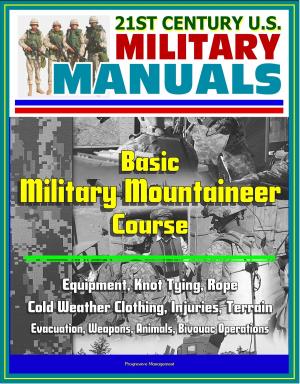Guide to American Military and Defense Strategy: The Grand Strategy of the United States, Army War College Guide to Strategy, Resources Mismatch, National Interests, History from 1787, War Strategy
Nonfiction, History, Military, Strategy, United States| Author: | Progressive Management | ISBN: | 9781311771995 |
| Publisher: | Progressive Management | Publication: | January 24, 2016 |
| Imprint: | Smashwords Edition | Language: | English |
| Author: | Progressive Management |
| ISBN: | 9781311771995 |
| Publisher: | Progressive Management |
| Publication: | January 24, 2016 |
| Imprint: | Smashwords Edition |
| Language: | English |
Professionally converted for accurate flowing-text e-book format reproduction, this unique book presents a dozen scholarly works about American military and warfare strategy, including the U.S. Army War College Guide to Strategy.
Contents: The Grand Strategy of the United States * U.S. Army War College Guide to Strategy * The Strategy-Resources Mismatch: Past, Present, and Future * American Grand Strategy In An Age Of Terrorism * U.S. Grand Strategy For The Future * America's Pursuit of the National Interests: Past, Present and Future * The Open Door: U.S. Grand Strategy From 1787 To 2008 * The Historical Foundations of U.S. Grand Strategy * American War Strategy: Restoring Coherence And Unity Of Effort * An Interagency Approach To Grand Strategy * U.S. Strategic Posture In A Nuclear Weapons Free World * A Proposed United States Grand Strategy for 2015 - 2030
From the earliest days of the Republic, the outlines of an evolving American grand strategy have been evident in our foreign and domestic policy. Much of that history continues to inform our strategic conduct, and therefore American grand strategy rests today on traditional foundations. Despite a welter of theory and debate, grand strategy as a practical matter is remarkably consistent from decade to decade, with its means altering as technology advances and institutions evolve but its ends and ways showing marked continuity. Grand strategy can be understood simply as the use of power to secure the state? Thus, it exists at a level above particular strategies intended to secure particular ends and above the use of military power alone to achieve political objectives. One way to comprehend grand strategy is to look for long-term state behavior as defined by enduring, core security interests and how the state secures and advances them over time. In a way, this means that what the state does matters more than what the state says. Grand strategy is therefore related to, but not synonymous with, National Security Strategies, National Military Strategies, Quadrennial Defense Reviews, or Defense Strategic Guidance. Grand strategy transcends the security pronouncements of political parties or individual administrations. Viewed in this light, American grand strategy shows great persistence over time, orienting on those things deemed most important—those interests for which virtually any administration will spend, legislate, threaten, or fight to defend.
For more than 3 decades, the Army War College Department of National Security and Strategy has faced the challenge of educating future strategic leaders on the subject of national security, or grand strategy. Fitting at the top of an officer's or government official's career-long, professional development program, this challenge has been to design a course on strategy that incorporates its many facets in a short period of time, all within the 1-year, senior service college curriculum. To do this, a conceptual approach has provided the framework to think about strategy formulation. The purpose of this volume is to present the Army War College's strategy formulation model to students and practitioners. This book serves as a guide to one method for the formulation, analysis, and study of strategy--an approach which we have found to be useful in providing generations of strategists with the conceptual tools to think systematically, strategically, critically, creatively, and big. Balancing what is described in the chapters as ends, ways, and means remains at the core of the Army War College's approach to national security and military strategy and strategy formulation.
Professionally converted for accurate flowing-text e-book format reproduction, this unique book presents a dozen scholarly works about American military and warfare strategy, including the U.S. Army War College Guide to Strategy.
Contents: The Grand Strategy of the United States * U.S. Army War College Guide to Strategy * The Strategy-Resources Mismatch: Past, Present, and Future * American Grand Strategy In An Age Of Terrorism * U.S. Grand Strategy For The Future * America's Pursuit of the National Interests: Past, Present and Future * The Open Door: U.S. Grand Strategy From 1787 To 2008 * The Historical Foundations of U.S. Grand Strategy * American War Strategy: Restoring Coherence And Unity Of Effort * An Interagency Approach To Grand Strategy * U.S. Strategic Posture In A Nuclear Weapons Free World * A Proposed United States Grand Strategy for 2015 - 2030
From the earliest days of the Republic, the outlines of an evolving American grand strategy have been evident in our foreign and domestic policy. Much of that history continues to inform our strategic conduct, and therefore American grand strategy rests today on traditional foundations. Despite a welter of theory and debate, grand strategy as a practical matter is remarkably consistent from decade to decade, with its means altering as technology advances and institutions evolve but its ends and ways showing marked continuity. Grand strategy can be understood simply as the use of power to secure the state? Thus, it exists at a level above particular strategies intended to secure particular ends and above the use of military power alone to achieve political objectives. One way to comprehend grand strategy is to look for long-term state behavior as defined by enduring, core security interests and how the state secures and advances them over time. In a way, this means that what the state does matters more than what the state says. Grand strategy is therefore related to, but not synonymous with, National Security Strategies, National Military Strategies, Quadrennial Defense Reviews, or Defense Strategic Guidance. Grand strategy transcends the security pronouncements of political parties or individual administrations. Viewed in this light, American grand strategy shows great persistence over time, orienting on those things deemed most important—those interests for which virtually any administration will spend, legislate, threaten, or fight to defend.
For more than 3 decades, the Army War College Department of National Security and Strategy has faced the challenge of educating future strategic leaders on the subject of national security, or grand strategy. Fitting at the top of an officer's or government official's career-long, professional development program, this challenge has been to design a course on strategy that incorporates its many facets in a short period of time, all within the 1-year, senior service college curriculum. To do this, a conceptual approach has provided the framework to think about strategy formulation. The purpose of this volume is to present the Army War College's strategy formulation model to students and practitioners. This book serves as a guide to one method for the formulation, analysis, and study of strategy--an approach which we have found to be useful in providing generations of strategists with the conceptual tools to think systematically, strategically, critically, creatively, and big. Balancing what is described in the chapters as ends, ways, and means remains at the core of the Army War College's approach to national security and military strategy and strategy formulation.















